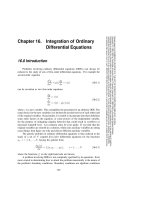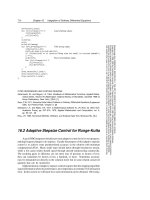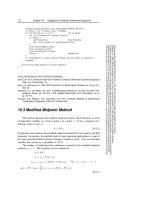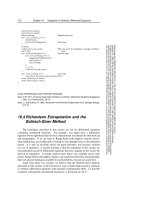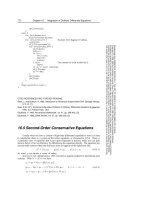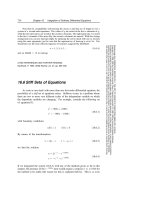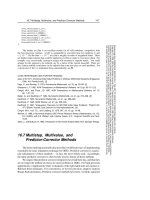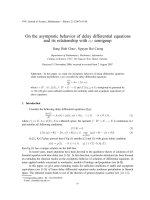On integral separation of nonautomous differential equations
Bạn đang xem bản rút gọn của tài liệu. Xem và tải ngay bản đầy đủ của tài liệu tại đây (231.86 KB, 37 trang )
MINISTRY OF EDUCATION AND TRAINING
HANOI PEDAGOGICAL UNIVERSITY 2
DEPARTMENT OF MATHEMATICS
Nguyen Thi Thu Huyen
ON INTEGRAL SEPARATION OF
NONAUTONOMOUS DIFFERENTIAL EQUATIONS
GRADUATION THESIS
Hanoi – 2019
MINISTRY OF EDUCATION AND TRAINING
HANOI PEDAGOGICAL UNIVERSITY 2
DEPARTMENT OF MATHEMATICS
Nguyen Thi Thu Huyen
ON INTEGRAL SEPARATION OF
NONAUTONOMOUS DIFFERENTIAL EQUATIONS
GRADUATION THESIS
SUPERVISOR: Assoc.Prof- Dr.Sc. Doan Thai Son
Hanoi – 2019
i
Thesis Acknowledgement
I would like to express my gratitudes to the teachers of the Department of Mathematics, Hanoi Pedagogical University 2, the teachers in
the Analytics group as well as the teachers involved. The lecturers
have imparted valuable knowledge and facilitated for me to complete
the course and the thesis.
In particular, I would like to express my deep respect and gratitude
to Assoc.Prof- Dr.Sc. Doan Thai Son, who has direct guidance, help me
complete this thesis.
Due to time, capacity and conditions are limited, so the thesis can
not avoid errors. Then, I look forward to receiving valuable comments
from teachers and friends.
Graduation thesis
Nguyen Thi Thu Huyen
Thesis Assurance
I assure that the data and the results of this thesis are true and not
identical to other topics. I also assure that all the help for this thesis
has been acknowledged and that the results presented in the thesis has
been identified clearly.
Ha Noi, May 5, 2019
Nguyen Thi Thu Huyen
i
Contents
Thesis Assurance
i
1 Lyapunov exponent and basic results
3
1.1
Definition and main properties of characteristic exponents
3
1.2
The Lyapunov spectrum of a linear system . . . . . . . .
11
2 Continuity of the Lyapunov exponent
2.1
2.2
22
Characterization of continuity of Lyapunov spectrum . .
23
2.1.1
Simple Lyapunov spectrum
. . . . . . . . . . . .
23
2.1.2
One point spectrum . . . . . . . . . . . . . . . . .
25
Explicit examples . . . . . . . . . . . . . . . . . . . . . .
27
REFERENCE
32
ii
Graduation thesis
Nguyen Thi Thu Huyen
Preface
Theory exponent Lyapunov has a long history and is known to be an
important tool in studying the stability of differential equations. Specifically, Lyapunov’s exponent measures the separation velocity of the nearderivative solutions of the differential equation and when the exponent
is negative, the solutions converge when the time is infinite. In fact,
there are many equations that we do not know exactly the vector field
and then the question is how the Lyapunov exponent will change if the
vector field of the system is small. One of the profound results associated with this problem is integral separation which is a necessary and
sufficient condition for the continuity of the Lyapunov exponent when
these exponents separate. Within the framework of the thesis, student
wished to present systematically the problem of continuity of the exponent Lyapunov and its relation to integral separation. To do this, the
thesis will focus on:
• Introduction sketchy to the Lyapunov exponent and basis results.
• Continuity of the Lyapunov exponent
The thesis consits of two chapter :
Chapter 1: Lyapunov exponent and basis results.
Chapter 2: Continuity of the Lyapunov exponent.
I sincerely thanks Assoc.Prof- Dr.Sc Doan Thai Son devotedly instructed the author to read the materials and practice the research. I
1
Graduation thesis
Nguyen Thi Thu Huyen
would also like to thank Assoc.Prof- Dr.Sc Doan Thai Son gave detailed
comments on how to present some results in the thesis.
I sincerely thank the teachers of the Mathematics Department at
Hanoi Pedagogical University 2, especially the Analysis Team, for creating favorable conditions for me in the process of studying at the University and implementing the thesis.
Ha Noi, 06/05/2019
Author of the thesis
Nguyen Thi Thu Huyen
2
Chapter 1
Lyapunov exponent and basic
results
The aim of this chapter is to introduce the notion of Lyapunov exponent
of an arbitrary function. Next, we study the Lyapunov spectrum of a
linear nonautonomous differential equation. We refer the reader to [2, 3]
for more details.
1.1
Definition and main properties of characteristic
exponents
We start this section by giving a definition of the Lyapunov characteristic exponent of a non-zero function. Roughly speaking this exponent
measures the growth of this function in comparison with the exponential
function.
Definition 1.1.1 (Lyapunov Characteristic exponent). For any nonzero function f : R → R, its Lyapunov characteristic exponent (for short
3
Graduation thesis
Nguyen Thi Thu Huyen
characteristic exponent) is defined as
1
χ[f ] = lim sup ln |f (t)|.
t→∞ t
The following properties is straightforward from Definition 1.1.1:
1. If |f (t)|
|F (t)| for t
a, then χ[f ]
χ[F ].
2. χ[f ] = χ[|f |].
3. χ[f ] = lim sup 1t ln |f (t)| = lim sup 1t (ln |c|+ln |f |) = lim sup 1t ln |cf | =
t→∞
t→∞
t→∞
χ[cf ], where c is an arbitrary non-zero constant.
4. For a non-zero constant function c, we have χ[c] = 0 .
Now, we study the property of the Lyapunov characteristic exponent
of a function given as a sum or a product of a finite number of functions.
For this purpose, we need the following technical lemma.
Lemma 1.1.2. Let f : R → R be a non-zero function. Then, χ[f ] =
α ∈ (−∞, ∞) if and only if for any ε > 0 the following two conditions
hold simultaneously:
|f (t)|
(α+ε)t
e
t→∞
(1) lim
= 0,
(t)|
(2) lim sup e|f(α−ε)t
= ∞.
t→∞
Proof. (Necessity) Suppose that
1
χ[f ] = lim sup ln |f (t)| = α.
t→∞ t
(1.1)
Then, we will show that two statements (1) and (2) hold. Choose and
4
Graduation thesis
Nguyen Thi Thu Huyen
fix ε > 0. By (1.1), there exists T > 0 such that
1
ε
ln |f (t)| < α +
t
2
for all t > T.
Equivalently,
ε
|f (t)| < e(α+ 2 )t
for all t > T,
which implies that
|f (t)| 1
. ε
ε
t→∞ e(α+ 2 )t e 2 t
1
= 0.
ε
t→∞ e 2 t
lim
lim
k→∞
Hence, (1) is verified. To prove (2), let a sequence tk −−−→ ∞ realizing
equality (1.1), it means that
1
ln |f (tk )| = α.
k→∞ tk
lim
Then, there exists N > 0 such that
ε
ln |f (tk )| > (α − )tk
2
for k > N.
Thus, we have
lim sup
k→∞
|f (tk )|
|f (tk )| ε tk
=
lim
sup
.e 2
(α− 2ε )tk
e(α−ε)tk
k→∞ e
ε
lim e 2 tk = ∞,
k→∞
which proves (2).
(Sufficiency) Suppose that two statements (1) and (2) hold. We will
show that χ(f ) = α. By condition (1), for any ε > 0 there exists T such
that
|f (t)| < e(α+ε)t
for all t ≥ T.
5
Graduation thesis
Nguyen Thi Thu Huyen
Equivalently,
1
ln |f (t)| < α + ε
t
for all t ≥ T.
Thus,
1
lim sup ln |f (t)|
t→∞ t
Since ε is arbitrary, χ(f )
α+ .
k→∞
α. Next, let a sequence tk −−−→ ∞ realize
equality (2) for an arbitrary but fixed ε > 0. By properties of supermum
of limit, for sufficient large k we have
|f (tk )| > e(α−ε)tk .
Equivalently,
1
tk
ln |f (tk )| > α −
χ(f ) = lim sup
t→∞
ε
2
for sufficient large k. Then,
1
ln |f (tk )|
tk
1
ln |f (tk )|
k→∞ tk
lim
ε
α− ,
2
which implies with the fact that ε is arbitrary that χ(f ) ≥ α. The proof
is complete.
Theorem 1.1.3 (Characteristic exponent of a sum of finite number
of functions). Let f1 , . . . , fn : R → R be non-zero functions. Define
f : R → R by
n
f (t) =
fi (t).
i=1
Then the following statements hold:
(i) The Lyapunov characteristic exponent f does not exceed the greatest
of the Lyapunov characteristic exponents of f1 , . . . , fn .
6
Graduation thesis
Nguyen Thi Thu Huyen
(ii) If only one functions has the greatest exponent of f1 , . . . , fn then
χ[f ] = max χ[fi ].
1≤i≤n
Proof. (i) Let α := max1≤i≤n χ[fi (t)] ∈ (−∞, ∞). According to Lemma
1.1.2, for any ε > 0 we get
|fi (t)|
=0
t→∞ e(α+ε)t
lim
Since |f (t)| ≤
n
i=1 |fi (t)|
for i = 1, . . . , n.
it follows that
|f (t)|
=0
t→∞ e(α+ε)t
lim
for i = 1, . . . , n.
Thus,
1
χ[f ] = lim sup ln |f (t)| ≤ α + ε.
t→∞ t
Since ε is arbitrary, we get χ[f ]
α
(ii). By definition of α and the assumption only one functions has the
greatest exponent of f1 , . . . , fn , there exists
χ[f ] = α,
∈ {1, . . . , n} such that
αk := χ[fk (t)] < α for k = 1, . . . , n; k = .
k)
Choose and fix an arbitrary ε ∈ (min (α−α
). Then, by Lemma 1.1.2
2
k=l
m→∞
there exists a sequence tm −−−→ ∞ such that
lim sup
m→∞
|f (t)|
= ∞.
e(α−ε)tm
7
Graduation thesis
Nguyen Thi Thu Huyen
We have
n
fk (tm )
k=1
e(α−ε)tm
|f (t)|
−
e(α−ε)tm
k=l
|fk (tm )|
e(αk +ε)tm .e(α−αk −2ε)tm
The second term on the right-hand side of the last inequality tends to
zero and the first tends to infinity as m → ∞. By properties of limit,
for sufficient large m we obtain
n
fk (tm ) > e(α−ε)tm .
k=1
Equivalently,
1
ln
tm
n
fk (tm )
> (α − ε).
k=1
Hence,
χ[f ]
1
ln
lim
m→∞ tm
n
fk (tm )
α − ε,
k=1
Which together with (i) implies that
n
χ[
fk (t)] = α.
k=1
The proof is complete.
Example 1.1.4. Using Theorem 1.1.3, we obtain that
χ[e2t + e3t + e−t ] = 3.
Theorem 1.1.5. The characteristic exponent of the product of a finite
number of function does not exceed the sum of the characteristic exponents of the cofactors, i.e., for any non-zero functions f1 , . . . , fn : R → R
8
Graduation thesis
Nguyen Thi Thu Huyen
we have
n
n
χ[fk ].
fk ]
χ[
(1.2)
k=1
k=1
Proof. We assume that +∞ and −∞ are not simultaneously present
among characteristic exponents. A direct computation yields that
n
χ[
k=1
1
fk ] = lim sup ln
t→∞ t
1
= lim sup
t→∞ t
n
≤
k=1
n
fk (t)
k=1
n
ln |fk (t)|
k=1
1
lim sup ln |fk (t)| =
t→∞ t
n
χ[fk ].
k=1
The proof is complete.
Example 1.1.6. 1)χ[et .e−3t ] = χ[e−2t ] = −2 and χ[et .e−3t ] = χ[et ] +
χ[e−3t ] = 1 − 3 = −2. In this case a strict equality is realized in (2.2)
2)χ[et sin t .e−t sin t ] = χ[1] = 0
At the same time. χ[et sin t .e−t sin t ] < χ[et sin t ] + χ[e−t sin t ] = 2
In this case a strict inequality is realized in (2.2)
Next, we define the characteristic exponent of a matrix-valued functions. Throughout the content of this thesis, we restrict our attention to
only matrix-valued functions taking the value in Rn×n .
Definition 1.1.7 (Lyapunov Characteristic Exponent of a Matrix-Valued Function). For any matrix F (t) = {fij (t)}i,j=1,..,n , its Lyapunov characteristic exponent (for short characteristic exponent) is defined as:
χ[F ] = max χ[fij ]
i,j
9
Graduation thesis
Nguyen Thi Thu Huyen
Now, we show that the characteristic exponent of a matrix-valued
function coincides with the characteristic exponent of its norm. To do
this, we recall that all norms on a finite-dimensional linear space are
equivalent. Then, in the following we endow Rn with the max norm, i.e.,
x = max |xi |.
i=1,...,n
For a linear map A : Rn → Rn , the norm A is defined as
A := max
n
x∈R \{0}
Ax
.
x
Suppose that A has a matrix presenation (aij )1≤i,j≤n . Then,
A = max |aij |.
1≤i,j≤n
Theorem 1.1.8. The charactertistic exponent of a finite dimensional
matrix F (t) coincides with the characteristic exponent of its norm, i.e.,
χ[F ] = χ[ F ].
Proof. By definition of norm of F (t), we have
|fij (t)|
F (t) ,
On the other hand, by Definition 1.1.7
χ[F ] = max χ[fij ]
i,j
Hence,
χ[F ] = max χ[fij ]
i,j
10
χ[ F (t) ].
(1.3)
Graduation thesis
Nguyen Thi Thu Huyen
On the other hand,
|fij (t)| .
F (t)
i,j
Hence,
χ[ F (t) ]
|fij (t)|] = χ[
χ[
i,j
fij (t)]
i,j
Consequently, by Theorem 1.1.3(i) we arrive at
χ[ F (t) ]
max χ[fij (t)],
which together with (2.4) implies that
χ[F ] = χ[ F ].
The proof is complete.
1.2
The Lyapunov spectrum of a linear system
Consider a linear nonautonomous differential equation
x˙ = A(t)x,
(1.4)
where A : [0, ∞) → Rn×n is a continuous function satisfying that
sup
A(t) ≤ M < ∞.
t∈[0,∞)
Our aim in this subsection is to examine the characteristic exponents
of the solution of (1.4). To do this, we first prove the existence of the
global solution of (1.4).
Theorem 1.2.1 (Global unique and existence of solution for linear
11
Graduation thesis
Nguyen Thi Thu Huyen
nonautonomous differential equations). Let x0 ∈ Rn be arbitrary. Then,
system (1.4) with the initial value condition x(0) = x0 has a unique
solution.
To prove the above theorem, we need to show the existence of a
unique continuous function x : [0, ∞) → Rn satisfying the following
integral equation
t
x(t) = x0 +
A(s)x(s) ds.
(1.5)
0
The idea is to find a suitable contraction operator on a suitable space
such that its unique fixed point of this operator gives rise to the solution
of (1.5). Now, choose and fix an arbitrary γ > 0. Let
C([0; +∞) , Rn ) = {f : [0; +∞) → Rn : f is continous}.
and
Cγ = {f ∈ C([0; +∞) , Rn ) : f
where f
γ
γ
< +∞},
:= sup e−γt f (t) for each f ∈ C([0; +∞) , Rn ).
t 0
Lemma 1.2.2. The space (Cγ , . γ ) is a Banach Space.
Proof. Firstly, we verify that (Cγ , . γ ) is norm space. Indeed, we check
three properties of a norm space:
f
γ
= 0 ⇔ sup e−γt f (t) = 0 ⇔ f (t) = 0
12
∀t ∈ [0; +∞)
Graduation thesis
Nguyen Thi Thu Huyen
and
f +g
γ
= sup e−γt f + g
sup e−γt ( f + g )
sup e−γt f + sup e−γt g
= f
αf
γ
γ
+ g
∀t ∈ [0; +∞) ,
γ
= sup e−γt αf = α sup e−γt f = α f
γ , ∀t
∈ [0; +∞) .
To complete the proof, we verify that the norm space .(Cγ , . γ ) is
complete. Now let Let {fn } be a Cauchy sequence in (Cγ , . γ ). Then, we
need to construct f ∗ ∈ Cγ such that lim fn = f ∗ . We do this throughout
the following steps:
Step 1: For a fixed t ∈ [0, ∞) We will show that {fn (t)} is a cauchy
sequence in R. Indeed, since {fn } is Cauchy in (Cγ , . γ ), ∀ε > 0, ∃N ∈ N
such that ∀n, m
N , we have:
fn − fm
γ
<
ε
eγt
So
e−γt fn (t) − fm (t) <
ε
.
eγt
Hence,
|fn (t) − fm (t)| < ε.
Therefore {fn (t)} is a Cauchy in R.
Step 2: Let f ∗ : [0; +∞) → R be defined by
f ∗ (t) := lim fn (t)
t ∈ [0; +∞) .
n→∞
We will show that f ∗ ∈ Cγ . Choose and fix t ∈ [0; +∞), we need to show
13
Graduation thesis
Nguyen Thi Thu Huyen
that f ∗ is continuous at t. For this purpose, let {tm }∞
m=1 be a sequence
such that lim tm = t. We need to show that lim f ∗ (tm ) = f ∗ (t).
m→∞
m→∞
Indeed, let ε > 0 be arbitrary but fixed. Since (fn ) is a Cauchy sequence
in Cγ , there exists K ∈ N such that
fn − fm
By definition of
γ
·
1 1
ε
< . min γt , γt
4 k∈N e e k
γ,
for all m, n ≥ K.
we have for all tk and t we have
ε
|fn (tk ) − fK (tk )| ≤ .
4
Letting n → ∞ yields that
ε
|f ∗ (tk ) − fK (tk )| ≤ .
4
Then
|f ∗ (tn ) − f ∗ (t)| = |f ∗ (tn ) − fK (tn ) + fK (tn ) − fk (t) + fK (t) − f ∗ (t)|
|f ∗ (tn ) − fK (tn )| + |fK (tn ) − fK (t)| + |fK (t) − f ∗ (t)|
ε
+ |fK (tn ) − fK (t)|
2
which together with continuity of the function fK proves the continuity
of the function f ∗ . Similarly, we aslo have f ∗
γ
< ∞. Therefore,
f ∗ ∈ Cγ .
Step 3: To complete the proof, we verify that
lim fn − f ∗
n→∞
γ
=0
Since {fn } is Cauchy sequence, so ∀ε > 0, ∃N ∈ N,such that ∀n, m
14
N,
Graduation thesis
Nguyen Thi Thu Huyen
we have:
fn − fm
γ
< ε.
So, for all t ∈ [0; +∞), we have
e−γt |fn (t) − fm (t)| < ε.
m→∞
Letting m → ∞ and using fm (x) −−−→ f ∗ (x), we obtain that
e−γt |fn (t) − f ∗ (t)|
∀n
ε
N.
Then
sup e−γt fn (t) − f ∗ (t)
ε
∀n
N,
t≥0
which means that
fn − f ∗
γ
for all n ≥ N.
<ε
Consequently,
lim fn − f ∗
n→∞
γ
=0
The proof is complete.
We are now in the position to prove the global uniqueness existence
of the solution of (1.4).
Proof of Theorem 1.2.3. Define a linear operator T : Cγ → Cγ by
t
Tf (t) = x0 +
A(s)f (s)ds.
0
Step 1. We will show that the linear operator Tf is well-defined, i.e.,
15
Graduation thesis
Nguyen Thi Thu Huyen
Tf ∈ Cγ . Since A(s)f (s) is continuous function, then by the Fundamental Theorem of Calculus, Tf (t) is a also continuous. Morover, we
have:
t
t
Tf
= x0 +
γ
x0
A(s)f (s)ds
0
We see that
x0
γ
γ
A(s)f (s)ds
+
0
γ
γ
< +∞ and
t
t
= sup e−γt
A(s)f (s)ds
A(s)f (s)ds
t≥0
0
0
γ
t
≤ M sup e
−γt
eγs f
t≥0
which implies that Tf (t)
γ
γ
ds < ∞,
0
< +∞.
Step 2. We will show that for a suitable choice of γ, the linear operator
T is contractive. Indeed, using the same estimate as in Step 1 we have
t
Tf − Tg
γ
−γt
eγs f − g
≤ M sup e
t≥0
≤
γ
ds
0
M
f − g γ,
γ
which implies that if γ > M the operator T is contractive.
Step 3. So far, T is contractive therefore by Banach Fixed Point Theorem, T has a unique fixed point. To conclude the proof, we will show
that ξ(t) is solution of (1.4) satisfying x(0) = x0 if and only if ξ(t) is a
fixed point of T .
˙ =
(Necessity) Suppose ξ(t) is solution of (1.4) with ξ(0) = x0 , i.e., ξ(t)
A(t)ξ(t)
16
Graduation thesis
Nguyen Thi Thu Huyen
Hence,
t
t
ξ(t) =
0
A(s)ξ(s)ds
∀t ∈ [0; +∞)
0
Since ξ(0) = x0 , the first integral is equal to :
ξ(t) − ξ(0) = ξ(t) − x0
So,
t
ξ(t) = x0 +
A(s)ξ(s)ds = T (ξ(t))
0
Thus, ξ(t) is a fixed point of T .
(Sufficiency) Suppose that ξ(t) satisfies:
t
A(s)f (s)ds, ∀t ∈ [0; +∞)
T (ξ(t)) = ξ(t) = x0 +
0
t
We set
Φ(t) =
A(s)f (s)ds
0
By the fundamental theorem of calculus, Φ(t) is continuous differentiable
and
t
Φ (t) =
A(t)ξ(t)
0
Thus, ξ(t) = x0 + Φ(t) is differentiable in [0; +∞) and
ξ(t) = Φ (t) = A(t).ξ(t)
Moreover,
0
ξ(0) = x0 +
A(s)ξ(s)ds = x0
0
17
Graduation thesis
Nguyen Thi Thu Huyen
Therefore, ξ(t) is solution of (1.4) with ξ(0) = x0 .
This complete the proof.
So far, we have proved that for any initial valued problem x(0) = x0
equation (1.4) has a unique solution. In the remainning of this chapter,
we examine the characteristic exponents of solutions of (1.4). Firstly,
we show that the characteristic exponent of a non-zero slution of (1.4)
is finite.
Theorem 1.2.3. Any non-trivial solution x(t) of the linear system (1.4)
−M ≤ χ[x] ≤ M .
has a finite characteristic exponent, i.e.
Proof. Let Rn be endowed with the Euclidean norm. A driect computation yields that
d x(t)
dt
2
= |< x(t),
˙
x(t) > + < x(t), x(t)
˙
>| = 2| < x,
˙ x>|
= 2 |< A(t)x(t), x(t) >| ≤ 2 A(t)x(t) . x(t)
≤ 2 A(t) . x(t)
2
≤ 2M x(t)
Therefore,
−2M x(t)
d x(t)
dt
2
Thus,
2
d x 2
x 2 dt
−2M
2
2M x(t)
2
2M.
Integrating the last inequality from t0 to t yields that
t
−
t
2M dτ
t0
t0
d x 2
dτ
x 2 dt
18
t
2M dτ .
t0
Graduation thesis
Nguyen Thi Thu Huyen
Therefore,
−2M (t − t0 )
ln x(t)
2
− ln x(t0 )
2
2M (t − t0 )
Consequently,
−M (1 −
t
)
t0
1
1
ln x(t) − ln x(t0 )
t
t
M (1 −
t
)
t0
Letting t → ∞, we get
That means −M
−M
1
lim sup ln x(t)
t→∞ t
χ[x]
M . The proof is complete.
M.
Next, we show that the set of Lyapunov characteristic exponents of all
non-zero solutions of (1.4) has no more than n elements. Before proving
this fact, we need the following technical lemmas.
Lemma 1.2.4. Vector functions x1 (t), ..., xm (t) defined on [0; ∞) and
having different finite characteristic exponents are linearly independent.
Proof. Let us consider the linear combination of these vectors with a
m
nontrivial set of coefficient is
ci xi (t). According to Theorem 1.1.3,
i=1
the characteristic exponent of this sum is equal to max χ[χi (t)]. That is,
i
m
ci xi (t)] = max χ[ci xi (t)] = max χ[χi (t)] = −∞
χ[
i
i=1
i
m
If ∃ ck = 0 such that
ci xi (t) = 0, then
i=1
m
ck xk (t)] = χ[0] = −∞
χ[
k=1
19
Graduation thesis
Nguyen Thi Thu Huyen
This is contradiction. Therefore, {xi }m
i=1 is linearly independent.
Lemma 1.2.5. System (1.4) has n solutions x1 (t), ..., xn (t) which are
linearly independent.
Proof. Suppose the contrary, i.e., there exists n+1 solutions x1 (t), ..., xn+1 (t)
of (1.4) which are linearly dependently. Then, there exists c1 , ..., cn+1
such that
c21 + ... + c2n+1 = 0 and c1 .x1 (0) + ... + cn+1 xn+1 (0) = 0.
Without loss of generality, we assume that c1 = 0. Then,
x1 (0) =
Put ξ(t) =
−c2
c1
c3
cn+1
−c2
x2 (0) − x3 (0) − .... −
xn+1 (0).
c1
c1
c1
x2 (t) −
c3
c1 x3 (t)
− .... −
cn+1
c1 xn+1 (t)
We have
˙ = −c2 x˙ 2 (t) − c3 x˙ 3 (t) − .... − cn+1 x˙ n+1 (t)
ξ(t)
c1
c1
c1
−c2
c3
cn+1
A(t)x2 (t) − A(t)x3 (t) − .... −
A(t)xn+1 (t)
=
c1
c1
c1
c2
c3
cn+1
= A(t).[− x2 (t) − x3 (t) − ... −
xn+1 (t)]
c1
c1
c1
= A(t).ξ(t)
Therefore, we have
for all t.
ξ(0) = x1 (0),
ξ(t) is the solution of equation x(t)
˙
= A(t)x(t).
Hence,
ξ(t) ≡ x1 (t),
20
